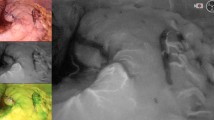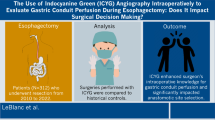Abstract
Background
Anastomotic leakage (AL) during Ivor-Lewis esophagectomy (ILE), owing to gastric conduit (GC) ischemia, is a serious complication. Measurement parameters during intraoperative ICG fluorescence angiography (ICG-FA) are unclear. We aimed to identify objective ICG-FA parameters associated with AL.
Study design
Patients > 18 years with an indication for ILE were enrolled. ICG-FA was performed at the abdominal and thoracic stage, and data, such as time of fluorescence appearance, speed of ICG perfusion, quality of GC perfusion (good, poor, ischemic), blood pressure, baseline patient characteristics, GC dimensions, and other intraoperative parameters were collected. On postoperative day 4 to 6, Gastrografin swallow radiography was performed. AL development was classified based on the Clavien–Dindo and SISG severity classifications. Univariate analysis with a 95% confidence level (p < 0.05) was performed. Factors with p < 0.05 were included in the multivariate analysis.
Results
100 patients were enrolled. During ICG-FA, evaluation of subjective perfusion was a very specific test (94.1%) with good negative predictive value (NPV 71.9%, p 0.034), but not powerful enough to detect patients at risk of leak (sensibility 21.8%, PPV 63.6%). The GC perfusion speed (cm/s) after gastric vascular isolation and before tubulization showed a significant association with AL (p < 0.003). Median arterial blood pressure in the thoracic stage (p < 0.001) or use of inotropic (p < 0.033) was associated with AL development.
Conclusion
GC perfusion speed at ICG-FA is an objective parameter that could predict AL risk. Other results emphasize the importance of the microcirculation in the development of AL.



Similar content being viewed by others
References
Huang L, Onaitis M (2014) Minimally invasive and robotic Ivor Lewis esophagectomy. J Thorac Dis 6:S314–S321
Alanezi K, Urschel JD (2004) Mortality secondary to esophageal anastomotic leak. Ann Thorac Cardiovasc Surg 10:71–75
Mitchell JD (2006) Anastomotic leak after esophagectomy. Thorac Surg Clin 16:1–9
Ryan CE, Paniccia A, Meguid RA, McCarter MD (2017) Transthoracic anastomotic leak after esophagectomy: current trends. Ann Surg Oncol 24:281–290
Karliczek A, Harlaar NJ, Zeebregts CJ et al (2009) Surgeons lack predictive accuracy for anastomotic leakage in gastrointestinal surgery. Int J Colorectal Dis 24:569–576
Karliczek A, Benaron DA, Baas PC et al (2008) Intraoperative assessment of microperfusion with visible light spectroscopy in esophageal and colorectal anastomoses. Eur Surg Res 41:303–311
Ikeda Y, Niimi M, Kan S et al (2001) Clinical significance of tissue blood flow during esophagectomy by laser Doppler flowmetry. J Thorac Cardiovasc Surg 122:1101–1106
Miyazaki T, Kuwano H, Kato H et al (2002) Predictive value of blood flow in the gastric tube in anastomotic insufficiency after thoracic esophagectomy. World J Surg 26:1319–1323
Servais EL, Rizk NP, Oliveira L et al (2011) Real-time intraoperative detection of tissue hypoxia in gastrointestinal surgery by wireless pulse oximetry. Surg Endosc 25:1383–1389
Desmettre T, Devoisselle JM, Mordon S (2000) Fluorescence properties and metabolic features of indocyanine green (ICG) as related to angiography. Surv Ophthalmol 45:15–27
Ladak F, Dang JT, Switzer N et al (2019) Indocyanine green for the prevention of anastomotic leaks following esophagectomy: a meta-analysis. Surg Endosc 33:384–394
Lerut T, Coosemans W, Decker G et al (2002) Anastomotic complications after esophagectomy. Dig Surg 19:92–98
Slooter MD, Eshuis WJ, Cuesta MA et al (2019) Fluorescent imaging using indocyanine green during esophagectomy to prevent surgical morbidity: a systematic review and meta-analysis. J Thorac Dis 11:S755–S765
Kumagai Y, Ishiguro T, Sobajima J et al (2016) Factors affecting blood flow at the tip of the reconstructed gastric tube during esophagectomy: a study using indocyanine green fluorescence angiography. Int Surg 101:381–389
Kumagai Y, Hatano S, Sobajima J et al (2018) Indocyanine green fluorescence angiography of the reconstructed gastric tube during esophagectomy: efficacy of the 90-second rule. Dis Esophagus. https://doi.org/10.1093/dote/doy052
Prasetya H, Jansen SM, Marquering HA et al (2019) Estimation of microvascular perfusion after esophagectomy: a quantitative model of dynamic fluorescence imaging. Med Biol Eng Comput 57:1889–1900
Ishige F, Nabeya Y, Hoshino I et al (2019) Quantitative assessment of the blood perfusion of the gastric conduit by indocyanine green imaging. J Surg Res 234:303–310
Ohi M, Toiyama Y, Mohri Y et al (2017) Prevalence of anastomotic leak and the impact of indocyanine green fluorescein imaging for evaluating blood flow in the gastric conduit following esophageal cancer surgery. Esophagus 14:351–359
Koyanagi K, Ozawa S, Oguma J et al (2016) Blood flow speed of the gastric conduit assessed by indocyanine green fluorescence. Medicine (Baltimore) 95:e4386
Wesselink EM, Kappen TH, Tom HM et al (2018) Intraoperative hypotension and the risk of postoperative adverse outcomes: a systematic review. Br J Anaesth 121:706–721
Low DE, Allum W, De Manzoni G et al (2019) Guidelines for perioperative care in esophagectomy: Enhanced Recovery After Surgery (ERAS®) Society recommendations. World J Surg 43:299–330
Klevebro F, Boshier PR, Low DE (2019) Application of standardized hemodynamic protocols within enhanced recovery after surgery programs to improve outcomes associated with anastomotic leak and conduit necrosis in patients undergoing esophagectomy. J Thorac Dis 11:S692–S701
Bahlmann H, Halldestam I, Nilsson L (2019) Goal-directed therapy during transthoracic oesophageal resection does not improve outcome: randomised controlled trial. Eur J Anesthesiol 36:153–161
Lin M, Shen Y, Feng M, Tan L (2019) Is two lung ventilation with artificial pneumothorax a better choice than one lung ventilation in minimally invasive esophagectomy? J Thorac Dis 11:S707–S712
Bizekis C, Kent MS, Luketich JD et al (2006) Initial experience with minimally invasive Ivor Lewis esophagectomy. Ann Thorac Surg 82:402–407
van Workum F, Berkelmans GH, Klarenbeek BR, Nieuwenhuijzen GA, Luyer MD, Rosman C (2017) McKeown or Ivor Lewis totally minimally invasive esophagectomy for cancer of the esophagus and gastroesophageal junction: systematic review and meta-analysis. J Thorac Dis 9:S826–S833
Acknowledgements
We would like to thank Editage (www.editage.com) for English language editing.
Funding
There has not been any direct or indirect financial support by extramural sources.
Author information
Authors and Affiliations
Contributions
R.R., P.P. and U.E. have done the study conception and design, analysis and interpretation of data and critical revision of the manuscript. E.T.-U. has helped in the acquisition of data, and has done the analysis and interpretation of data and drafting of the manuscript. S.T. has helped in the analysis and interpretation of data, and in the drafting of the manuscript. A.C. contributed to the study conception and design, and has helped in the acquisition of data. M.P., G.O. and L.B. have helped in the acquisition of data.
Corresponding author
Ethics declarations
Disclosures
Drs. Eider Talavera-Urquijo, Paolo Parise, Marco Palucci, Greta Olivari, Stefano Turi, Andrea Cossu, Lavinia Barbieri, Ugo Elmore and Riccardo Rosati have no conflicts of interest or financial ties to disclose.
Additional information
Publisher's Note
Springer Nature remains neutral with regard to jurisdictional claims in published maps and institutional affiliations.
Rights and permissions
About this article
Cite this article
Talavera-Urquijo, E., Parise, P., Palucci, M. et al. Perfusion speed of indocyanine green in the stomach before tubulization is an objective and useful parameter to evaluate gastric microcirculation during Ivor-Lewis esophagectomy. Surg Endosc 34, 5649–5659 (2020). https://doi.org/10.1007/s00464-020-07924-7
Received:
Accepted:
Published:
Issue Date:
DOI: https://doi.org/10.1007/s00464-020-07924-7




